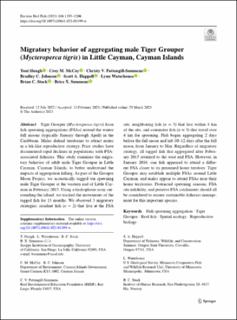Migratory behavior of aggregating male Tiger Grouper (Mycteroperca tigris) in Little Cayman, Cayman Islands
Sleugh, Toni; McCoy, Croy M.; Pattengill-Semmens, Christy V.; Johnson, Bradley C.; Heppell, Scott A.; Waterhouse, Lynn; Stock, Brian; Semmens, Brice X.
Peer reviewed, Journal article
Published version
Permanent lenke
https://hdl.handle.net/11250/3103614Utgivelsesdato
2023Metadata
Vis full innførselSamlinger
- Articles [3012]
- Publikasjoner fra CRIStin [3070]
Sammendrag
Tiger Grouper (Mycteroperca tigris) form fish spawning aggregations (FSAs) around the winter full moons (typically January through April) in the Caribbean. Males defend territories to attract mates in a lek-like reproductive strategy. Prior studies have documented rapid declines in populations with FSA-associated fisheries. This study examines the migratory behavior of adult male Tiger Grouper in Little Cayman, Cayman Islands, to better understand the impacts of aggregation fishing. As part of the Grouper Moon Project, we acoustically tagged ten spawning male Tiger Grouper at the western end of Little Cayman in February 2015. Using a hydrophone array surrounding the island, we tracked the movements of the tagged fish for 13 months. We observed 3 migratory strategies: resident fish (n = 2) that live at the FSA site, neighboring fish (n = 5) that live within 4 km of the site, and commuter fish (n = 3) that travel over 4 km for spawning. Fish began aggregating 2 days before the full moon and left 10–12 days after the full moon, from January to May. Regardless of migratory strategy, all tagged fish that aggregated after February 2015 returned to the west end FSA. However, in January 2016, one fish appeared to attend a different FSA closer to its presumed home territory. Tiger Grouper may establish multiple FSAs around Little Cayman, and males appear to attend FSAs near their home territories. Protracted spawning seasons, FSA site infidelity, and putative FSA catchments should all be considered to ensure sustainable fisheries management for this important species.
